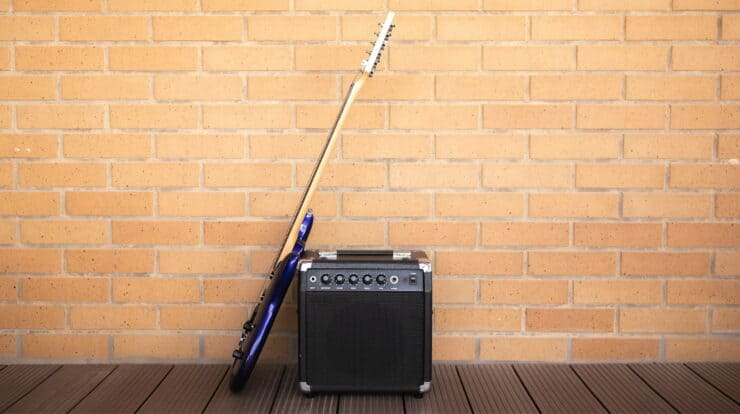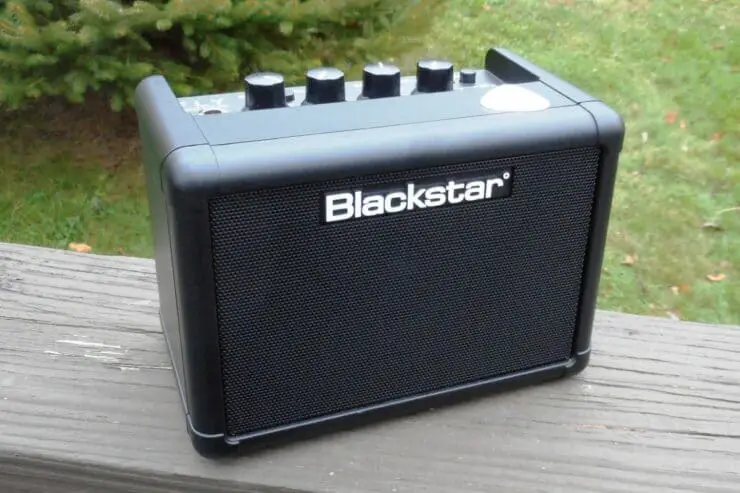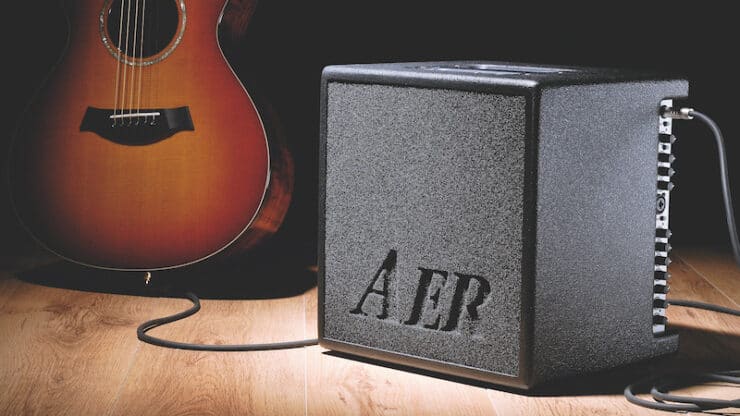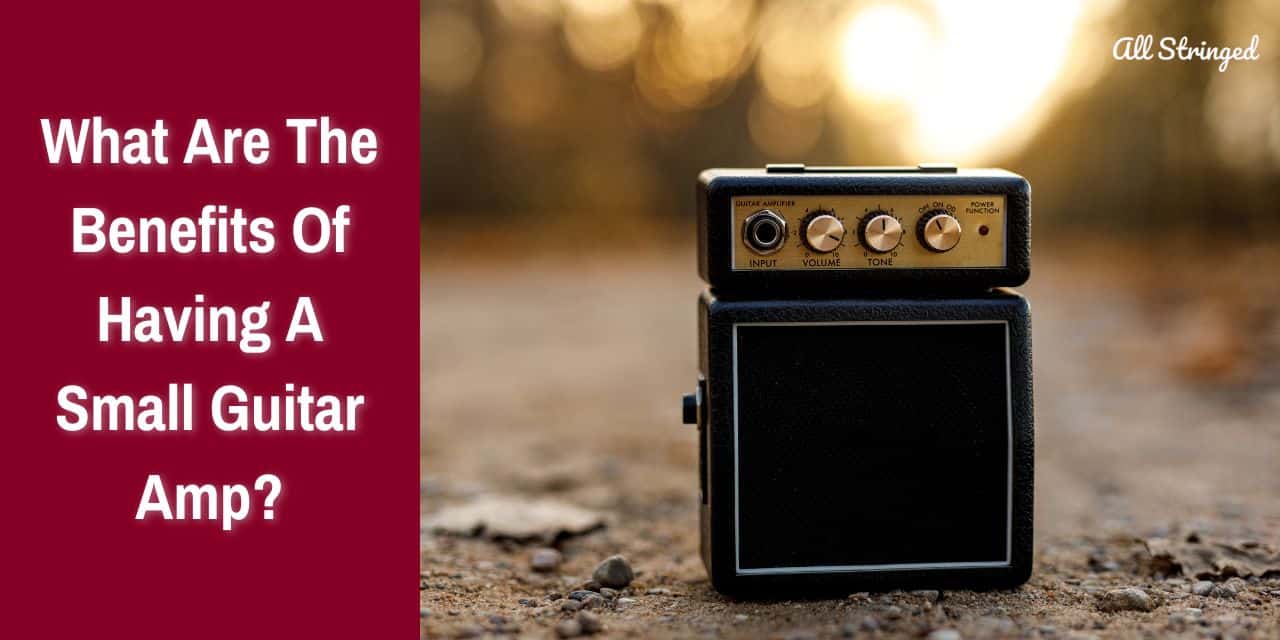Are you a guitar player looking to explore new sounds? Small amps are an essential part of any guitarist’s sound palette, and they can provide a range of tonal possibilities that you may not have considered before. In this article, we’ll discuss the advantages of having a small guitar amp and how you can make the most of it to create your own unique sound. Read on to discover why you should consider investing in a small amp for your next jam session!
Overview of small guitar amps
A small guitar amp is a compact and portable amp designed specifically for electric guitars. It is versatile equipment that allows musicians and guitarists to amplify their sound and add various effects while maintaining a compact and lightweight form factor. Small guitar amps are the ideal alternative to larger and more powerful guitar amps. Although they might be physically smaller, these amps are still capable of producing impressive sound quality and a wide range of tones.

The different components of a small guitar amp are –
#1. Amplifier circuit
The heart of a small guitar amp is its amplifier circuit. It is responsible for taking the weak electrical signal from the guitar and boosting it to produce a louder sound. The amplifier circuit consists of preamp and power amp sections, which help shape and amplify the guitar’s signal.
>>> Click here to read our review about the Top 15 Best Small Guitar Amps <<<
#2. Speaker
Small guitar amps typically feature a built-in speaker that projects the amplified sound. The size and configuration of the speaker could vary depending on the specific model but it is designed to reproduce the guitar’s tones accurately and with clarity.
#3. Controls and inputs
Small guitar amps come equipped with a wide range of controls and inputs to customize your sound. These include volume, tone, gain, and equalizer knobs, allowing you to shape the tone to suit your preferences. Additionally, most small amps come with input jacks to connect your guitar, headphone jacks for private practice, and auxiliary inputs for playing along with backing tracks or connecting external devices.
Benefits of using a small guitar amp
When it comes to playing the electric guitar, having the right equipment will be essential. While larger guitar amps certainly have their significance, small guitar amps also offer an impressive range of unique benefits that make them extremely valuable assets for musicians and guitarists. Here are some of the major benefits of using a small guitar amp and how it can greatly enhance your playing experience.
#1. Portability and convenience
One of the standout benefits of a small guitar amp is its portability. These compact amps are lightweight and easy to transport, making them perfect for musicians who are always on the move. Whether you are jamming with friends, practicing at home, or gigging at smaller venues, a small guitar amp can easily be carried along without any hassle. Its portable nature will allow you to take your music wherever you go and be ready to perform at a moment’s notice.
#2. Practice anytime, anywhere
Small guitar amps are a boon for practice sessions. They’ll allow you to practice your guitar skills anytime and anywhere without disturbing others around you. With the option to plug in headphones, you’ll be able to enjoy silent practice sessions even late at night. This feature is especially valuable for students, apartment dwellers, and those with shared living spaces. The ability to control the volume on a small guitar amp also allows you to easily fine-tune your playing without compromising on sound quality.
#3. Versatile tonal options
Despite their compact size, small guitar amps also offer a surprising range of tonal options. Many models come with various built-in effects and tone-shaping controls, allowing you to experiment with different sounds and create your desired tones.
Whether you’re looking for a clean, classic tone or a heavily distorted sound, a small guitar amp can cater to your musical preferences. Some amp models even incorporate digital modeling technology, replicating the sounds of iconic amps and expanding your tonal possibilities.
#4. Ideal for small venues and intimate performances
When you’re performing in smaller venues or intimate settings, a large guitar amp might overpower the space or create unnecessary volume issues. Meanwhile, a small guitar amp will be perfectly suited for such scenarios as it’ll provide the right amount of amplification without sacrificing sound quality.
You will be able to achieve a balanced mix, ensuring that your guitar’s sound is heard clearly without overpowering other instruments or vocals. Small amps are ideal for acoustic performances, allowing you to amplify your guitar while maintaining a natural and intimate sound.
#5. Cost-effective
Compared to large guitar amps, a small guitar amp is often more affordable. This makes them an extremely attractive option for beginners musicians or guitarists who are on a budget.
Small guitar amps provide an entry point into the world of guitar amplification without having to break the bank. Moreover, their compact size means that they require less space, making them suitable for musicians who have limited room or are just starting their musical journey.
Different types of small guitar amps
Small guitar amps are essential tools for musicians and guitarists looking for a compact and portable solution without having to sacrifice quality and tone. Small guitar amps come in various types and each type offers unique characteristics and sonic qualities that cater to specific needs and playing styles. By understanding the difference between different types of small tube amps, you will be in a better position to make a well-informed decision and choose the ideal small guitar amp for your needs. Here are the different types of small guitar amps that you can choose from –
Small tube amps
Small tube amps or also known as valve amps are highly revered for their warm, organic, and dynamic sound. Such amps make use of vacuum tubes for amplifying the guitar signal, resulting in rich harmonics, and a responsive tone. Some of the key features of small tube amps include their signature tonal characteristics, warmth and depth, maintenance, and more.
Small tube amps are known for their extremely smooth and natural overdrive when they’re pushed to higher volumes. They offer a dynamic range and a pleasing breakup that many musicians and guitarists find desirable for rock, blues, and vintage tones. Moreover, tube amps also produce a warm and rounded sound with natural compression, adding depth and character to your guitar’s tone. These amps excel in capturing the nuances and dynamics of your guitar playing.
These devices require periodic maintenance as the tubes might need replacement over time. These amps are more delicate compared to other types and can be sensitive to temperature changes, requiring careful handling.
Small solid-state amps
Small solid-state amps make use of transistors and digital circuitry for amplifying the guitar signal. They offer an extremely reliable and cost-effective solution for guitar amplification. The key features of small solid-state amps include reliability, durability, clarity, precision, affordability, and more.
Small solid-state amps are known for their incredibly robust construction and durability. They’re less prone to component failure and need minimal maintenance. Further, they are able to provide clean and precise sound reproduction. They have a fast response and are capable of delivering consistent tone at any volume level, making them suitable for music genres that demand clarity, such as funk and jazz.
These amps are typically more affordable compared to small tube amps. This makes them an attractive option for beginners musicians or guitarists on a budget.

Small digital modeling amps
Small digital modeling amps combine Digital Signal Processing (DSP) technology with software algorithms to emulate the sound and characteristics of various amplifier models. They offer a wide range of tonal options and effects. The key features of small digital modeling amps include versatility, portability, convenience, customization, and more.
Small digital modeling amps offer access to an extensive selection of amp models, from classic tube amps to modern high-gain stacks. They also offer a wide variety of built-in effects, giving you the flexibility to experiment with different tones and styles. These amps also offer compact designs and built-in speakers, which makes them highly portable and suitable for practice sessions or small gigs. They can also be connected to recording software or audio interfaces for direct recording.
Such amps will also allow you to tweak and adjust various parameters for creating your unique tone. They offer the ability to save and recall presets, making it very easy to switch between different sounds during a performance.
Practice amps
Practice amps are highly compact and designed primarily for home use and personal practice sessions. These amps typically come with low wattage and smaller speaker sizes, making them perfect for quiet playing environments. Some of the key features of practice amps include portability, simple controls, and affordability among others.
Practice amps are extremely lightweight and easy to transport, making them ideal for practicing on the go or in smaller spaces. They often feature basic tone controls, volume adjustments, and headphone jacks for silent practice. Some models also include built-in effects like reverb or delay. These amps are generally budget-friendly, which makes them an amazing option for beginners or players on a tight budget.
Mini amps
Mini amps are incredibly compact and ultra-portable, which will allow you to take your guitar sound with you wherever you go. These pint-sized amps offer surprising power and convenience. Some of the key features of mini amps include portability, basic functionality, the ideal option for beginners, and battery-powered.
Mini amps are small enough that they can fit in a backpack or gig bag, making them ideal for traveling or impromptu jam sessions. Most mini amps are battery-powered, which provides the freedom to play anywhere without needing an external power source.
While they might lack extensive controls, mini amps often include essential tone adjustments, volume control, and headphone jacks for private practice. Brands like Boss, Blackstar, and more are great options for beginners who looking for a compact and affordable solution to practice at home or on the go.
Small hybrid amps
Small hybrid amps combine the best of both tube and solid-state technologies, offering a versatile and unique sonic experience. These amps typically use a combination of tubes and solid-state circuitry. The key features of small hybrid amps include warmth, versatility, power, performance, enhanced tonal options, customization, and more.
Small hybrid amps aim to offer the warmth and responsiveness of tube amps while incorporating the reliability and flexibility of solid-state components. They often come with an impressive range of built-in effects, amp modeling, and digital processors, giving you a wide variety of tones and sonic possibilities.
These amps can deliver higher wattage and more volume compared to mini amps, making them better suited for small gigs or rehearsals. Many small hybrid amps also offer additional tone-shaping controls, presets, and connectivity options, allowing for better sound customization and integration with external devices.

How to choose a small guitar amp?
When it comes to choosing the ideal small guitar amp, several important factors play an important role. These key factors will help you decide the right amp for your needs and taste. Here are the factors you need to keep in mind when you are in the market for a new small guitar amp.
#1. Power rating
The power rating of a small guitar amp refers to the amount of electrical power it can deliver to the speaker. It is typically measured in watts. You must consider certain points like intended use, volume requirements, and more when evaluating the power rating.
First, you need to determine where and how you’re planning to use the new guitar amp. For home practice, lower wattage amps (5-20W) are usually sufficient. For small gigs or rehearsals, higher wattage options (20-50W) might be necessary.
You should also assess the volume levels that you need. Higher wattage amps will provide more headroom and can achieve louder volumes without distortion. Lower wattage amps can offer desirable overdrive and saturation at lower volumes.
#2. Speaker size
The speaker size generally influences the overall sound and tonal characteristics of an amp. Larger speakers typically produce more low-end responses and can easily handle higher volumes. Meanwhile, smaller speakers are much more focused on midrange and high-end frequencies. Smaller speakers are found in compact and portable amps, making them better suited for travel and practice on the go.
#3. Tone controls
Tone controls on a small guitar amp will allow you to shape the overall sound and achieve your desired tonal characteristics. Basic guitar amps come with a simple three-band EQ (bass, treble, mid) whereas more advanced amps offer additional controls like presence, contour, or sweepable midrange.
You must consider the range of tone-shaping options offered by the guitar amp. This will allow you to customize your sound and adapt to different musical styles and playing techniques.
You must consider the range of tone-shaping options offered by the guitar amp. This will allow you to customize your sound and adapt to different musical styles and playing techniques.
#4. Effects
Built-in effects can greatly enhance your playing experience and provide an impressive range of sonic possibilities. Some small guitar amps come with built-in effects like delay, reverb, modulation (phaser, chorus, flanger), and even amp modeling. You need to determine which effects are needed for your style and make sure that your preferred amp provides them.
Prefer an amp that delivers an effect loop. An effects loop will allow you to easily connect external effects pedals or processors, giving you the flexibility to expand your sonic palette.
#5. Connectivity
Connectivity options will be vital for integrating your guitar amp with other devices or equipment. Make sure your amp has the necessary inputs and outputs to accommodate your setup, including instrument input, auxiliary input, headphone output, and line out.
Some small guitar amps also offer USB or Bluetooth connectivity. Such connectivity options will allow you to connect to recording software, playback devices, or use mobile apps for additional control and versatility.
Important tips for using a small guitar amp
Small guitar amps offer a convenient and portable solution for practicing and recording. Whether have to hone your skills at home or capture your musical ideas in the studio, small guitar amps will deliver impressive tones and versatility in most situations. Here are the important tips to remember for using a small guitar amp effectively for practicing and recording purposes, helping you get the most out of your amp.
Tips for using a small guitar amp for practice
#1. Adjust the amp’s volume
When using a small guitar amp, you must begin by setting the amp at a comfortable volume level suitable for practicing in your environment. You need to consider using the headphone output if you have to practice silently without disturbing others.
#2. Explore and experiment with gain and tone
Small guitar amps often come with simplified controls. This means you must make the most of the available tone-shaping options. Explore different combinations of bass, mid, treble, and gain settings to achieve the desired sound for your practice sessions.
#3. Make use of built-in effects
Many small guitar amps come with built-in effects like delay, reverb, or modulation. You must experiment with different effects to add depth and ambiance to your playing. However, you should avoid relying too heavily on effects and ensure your core tone remains intact.
#4. Practice dynamic playing
They can be quite responsive to subtle nuances in your playing. Take full advantage of this by practicing dynamic techniques like fingerpicking, palm muting, and varying your picking intensity. This will help you develop better control over your playing dynamics and explore the tonal capabilities of your small amp.
Tips for using a small guitar amp for recording
#1. Experiment with mic placement
Positioning the microphone correctly will be important for capturing the best sound from your small guitar amp. Place the mic close to the speaker cone for a focused and more direct sound or move it slightly further away to get a more ambient and roomy sound. You can also experiment with different mic placements to find the sweet spot that suits your desired tone.
#2. Utilize different mic types
Try to use different microphone types for capturing different sonic characteristics. Dynamic mics are durable and work well for close-miking whereas condenser mics offer a more detailed and accurate sound representation. You can also experiment with different mics to find the one that best complements your amp’s tone.
#3. Layer multiple tracks
Small guitar amps can produce amazing results when recording multiple tracks. Experiment with layering rhythm and lead parts, doubling guitar lines, or adding harmonies for creating a fuller and more dynamic sound.
#4. Enhance the tone with post-processing
Once you have recorded your guitar tracks with a small amp, take full advantage of post-processing techniques. Make use of EQ, compression, and other effects for shaping the recorded sound, adding depth, or enhancing certain frequencies to achieve a more polished and professional mix.
FAQs
What are the benefits of having a small guitar amp?
Small guitar amps are becoming increasingly popular due to their convenience, portability, and affordability. Small amps are ideal for practice and are typically more affordable than larger, higher wattage amps. They are also easier to transport, making them great for use on the go. Small amps still offer great sound quality and may even offer features such as headphone jacks and aux inputs.
What are the drawbacks of having a small guitar amp?
The main drawback of having a small amp is that it may not have enough power for louder performances or for use in larger venues. Small amps also tend to have limited tone shaping capabilities, as they typically only have a few knobs for controlling volume, tone, and reverb.
What should I consider when choosing a small guitar amp?
When choosing a small guitar amp, it’s important to consider your budget, playing style, musical needs, and available space. It’s also important to consider the wattage and speaker size, as these will determine the amp’s power and sound quality. Portable amps are also available for practice on the go, and these typically have built-in batteries and headphone jacks for silent practice.



